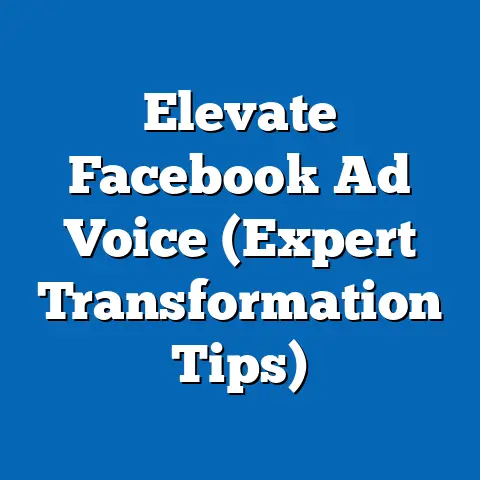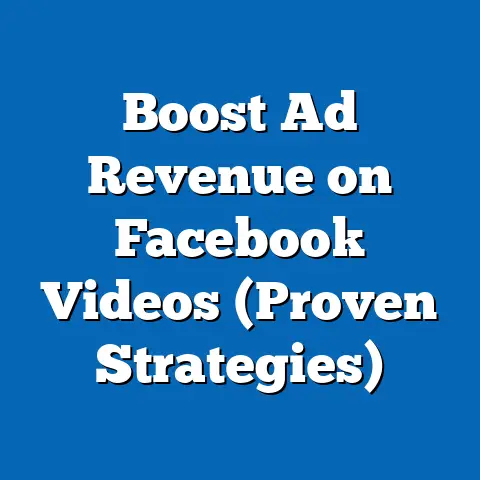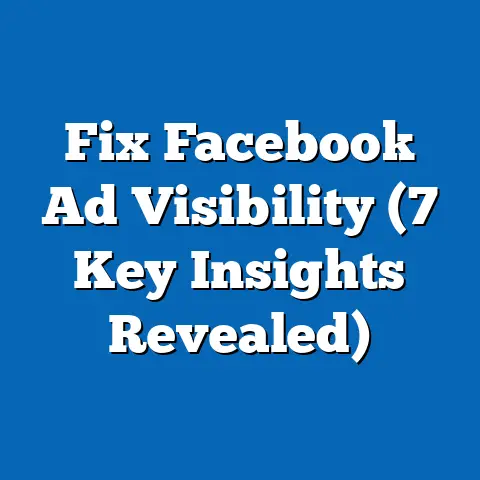Boost fb ad Spend Limit (Unlock Hidden Budget Potential)
Have you ever felt like your Facebook ad campaigns were hitting a ceiling, preventing you from reaching your full potential? I know I have! It’s frustrating to feel limited, especially when you see the potential for even greater results. Did you know that a significant portion of businesses are not maximizing their Facebook ad budgets due to unseen limitations? What if you could tap into an unseen reservoir of budget potential that could dramatically amplify your advertising effectiveness? This article is your guide to unlocking that hidden budget potential and taking your Facebook ad campaigns to the next level.
Understanding Facebook Ad Spend Limits
Facebook ad spend limits are essentially caps placed on the amount of money you can spend on your campaigns within a given timeframe. These limits aren’t always explicitly stated, which is why they can feel like a hidden obstacle. They are put in place by Facebook to manage risk and ensure a positive user experience.
Why do they matter? For starters, they directly impact your reach, engagement, and ultimately, your ROI. If you’re hitting a limit before you’ve exhausted your target audience or achieved your desired results, you’re leaving money (and potential customers) on the table. Understanding these limits is crucial for scaling your campaigns effectively and achieving your business goals.
The concept of “hidden budget potential” refers to the untapped advertising reach and impact that lies dormant due to these imposed spending restrictions. Many advertisers are unaware of these limits, or they don’t know how to navigate them effectively. This lack of awareness can lead to suboptimal campaign performance and missed opportunities. This guide is designed to help you become aware of these limits and unlock the hidden potential of your budget.
Takeaway: Facebook ad spend limits exist, and understanding them is the first step to unlocking hidden budget potential and maximizing your advertising impact.
The Mechanics Behind Spend Limits
So, how does Facebook actually determine these ad spend limits? It’s not just a random number they pull out of a hat! Several factors come into play, and understanding them can help you influence your limits over time.
- Account History: A new ad account will naturally have lower spending limits compared to an established account with a proven track record. Facebook needs to build trust, and that comes with time and consistent, positive performance. I remember when I first started, my daily spend was capped at a ridiculously low amount. It was frustrating, but I understood the need for Facebook to verify my legitimacy.
- Ad Performance: If your ads are performing well – meaning high engagement, low cost-per-click (CPC), and positive user feedback – Facebook is more likely to increase your spending limits. Conversely, poor-performing ads can lead to restrictions.
- Payment Methods: The payment method you use can also influence your limits. Credit cards are generally viewed as more reliable than debit cards, and linking a verified bank account can further boost your credibility.
- Ad Account Standing: Violations of Facebook’s advertising policies, such as promoting prohibited content or using deceptive practices, will almost certainly result in lowered spending limits or even account suspension.
It’s also important to understand the difference between daily and lifetime budgets. Daily budgets set an average amount you’ll spend per day, while lifetime budgets set a total amount for the entire duration of your campaign. While both are subject to spending limits, daily budgets offer more flexibility for scaling and optimization. If you reach your daily budget limit, Facebook will stop showing your ads for the rest of the day, potentially missing out on valuable impressions and clicks.
Let’s look at some examples:
- Example 1: New Advertiser: A brand new ad account might have a daily spending limit of $50. This advertiser needs to focus on creating high-quality ads, targeting the right audience, and consistently adhering to Facebook’s policies to gradually increase their limit.
- Example 2: Poor Performing Ads: An advertiser with a history of low-engagement ads and high CPCs might find their spending limit capped, even with an established account. They need to revamp their ad creative, refine their targeting, and optimize their campaigns for better performance.
- Example 3: Policy Violation: An advertiser who violates Facebook’s advertising policies, even unintentionally, could face severe restrictions on their spending limits and potentially have their account suspended.
I’ve seen advertisers inadvertently restrict their ad spending capabilities by:
- Setting overly restrictive targeting: Narrowing your audience too much can limit your reach and prevent Facebook from effectively optimizing your campaigns.
- Using low-quality ad creative: Poorly designed ads with irrelevant content will result in low engagement and high costs, signaling to Facebook that your ads aren’t valuable to users.
- Ignoring Facebook’s advertising policies: Even unintentional violations can lead to penalties and restrictions on your spending limits.
Takeaway: Facebook’s ad spend limits are determined by a combination of factors, including account history, ad performance, payment methods, and adherence to policies. Understanding these mechanics is crucial for influencing your limits and unlocking hidden budget potential.
Identifying Hidden Budget Potential
Now that we understand the mechanics, how do we actually identify this hidden budget potential? It’s like searching for buried treasure – you need the right tools and a keen eye to find it!
The first step is to analyze your current ad performance and spending efficiency. Don’t just look at the overall spend; dig deeper into the metrics that reveal how effectively you’re using your budget.
Here are some key tools and metrics to consider:
- Facebook Ads Manager: This is your central hub for monitoring and analyzing your campaigns. Pay close attention to metrics like:
- Cost Per Result (CPR): How much are you spending to achieve your desired outcome (e.g., lead, purchase, website visit)? A high CPR indicates inefficiency.
- Click-Through Rate (CTR): What percentage of people who see your ad actually click on it? A low CTR suggests your ad isn’t resonating with your audience.
- Relevance Score (for older campaigns): This metric (now largely replaced by ad ranking diagnostics) measures how relevant your ad is to your target audience. A low score indicates poor targeting or ad creative.
- Return on Ad Spend (ROAS): This metric measures the revenue generated for every dollar spent on advertising. A higher ROAS means that you are getting more value for your money.
- Facebook Audience Insights: This tool allows you to analyze the demographics, interests, and behaviors of your target audience. Use it to identify potential audience segments that you might be missing.
- Google Analytics: If you’re driving traffic to your website, Google Analytics can provide valuable insights into user behavior after they click on your ad. Are they converting? Are they engaging with your content? Use this data to optimize your landing pages and ad creative.
- Cost Per Result (CPR): How much are you spending to achieve your desired outcome (e.g., lead, purchase, website visit)? A high CPR indicates inefficiency.
- Click-Through Rate (CTR): What percentage of people who see your ad actually click on it? A low CTR suggests your ad isn’t resonating with your audience.
- Relevance Score (for older campaigns): This metric (now largely replaced by ad ranking diagnostics) measures how relevant your ad is to your target audience. A low score indicates poor targeting or ad creative.
- Return on Ad Spend (ROAS): This metric measures the revenue generated for every dollar spent on advertising. A higher ROAS means that you are getting more value for your money.
I find that one of the biggest opportunities for unlocking hidden budget potential lies in identifying low-performing ads. These are the ads that are eating up your budget without delivering the desired results.
Here’s my process for identifying and addressing low-performing ads:
- Run an A/B test: Test different ad creatives, targeting options, and placements to see what performs best. I’ve often been surprised by which ads resonate with my audience.
- Pause or Kill the ads: If an ad consistently underperforms, don’t be afraid to pause or kill it. It’s better to reallocate that budget to higher-performing ads.
- Reallocate Funds: Once you’ve identified and eliminated low-performing ads, reallocate those funds to your top-performing campaigns. This can significantly boost your overall ROI.
For example, I once had a campaign with several ads targeting the same audience. After analyzing the data, I realized that one ad was responsible for the majority of the conversions, while the others were barely generating any results. I paused the low-performing ads and reallocated their budget to the winning ad. The result? A significant increase in conversions and a lower overall cost per conversion.
Takeaway: Identifying hidden budget potential requires a thorough analysis of your current ad performance, the use of relevant tools and metrics, and a willingness to eliminate low-performing ads and reallocate resources to your top-performing campaigns.
Strategies to Boost Spend Limits
Okay, you’ve identified the potential – now, let’s talk about strategies to actually boost those spend limits! It’s not about gaming the system; it’s about demonstrating to Facebook that you’re a responsible and valuable advertiser.
Here are some actionable strategies to consider:
- Improve Account Quality: This is the foundation for increasing your spending limits. Make sure your business information is accurate and up-to-date, your payment methods are verified, and you’re consistently adhering to Facebook’s advertising policies.
- Optimize Existing Campaigns: Focus on improving the performance of your existing campaigns. This means creating high-quality ad creative, targeting the right audience, and optimizing your bids for maximum efficiency.
- Consistent Ad Performance: Maintaining a positive ad account status is crucial for long-term success. Avoid policy violations, respond promptly to user feedback, and consistently deliver high-quality ads that resonate with your audience.
- Payment Methods: As mentioned earlier, your payment method can influence your spending limits. Consider upgrading to a credit card or linking a verified bank account to boost your credibility.
- Requesting an Increase: Once you’ve demonstrated a track record of responsible advertising and positive performance, you can request an increase in your spending limits through the Facebook Ads Manager. While there’s no guarantee, it’s worth a shot!
I want to emphasize the importance of consistent ad performance. Facebook rewards advertisers who consistently deliver high-quality ads that provide value to users. This means avoiding clickbait, deceptive practices, and irrelevant content.
I remember one instance where I had a client who was struggling to increase their spending limits. After auditing their account, I discovered that they were using aggressive targeting tactics and clickbait headlines to drive traffic to their website. I advised them to revamp their ad creative, refine their targeting, and focus on delivering genuine value to their audience. Within a few weeks, their ad performance improved significantly, and their spending limits were gradually increased.
Takeaway: Boosting your ad spend limits requires a combination of improving account quality, optimizing existing campaigns, maintaining consistent ad performance, and potentially upgrading your payment methods.
Case Studies and Success Stories
Let’s bring these strategies to life with some real-world examples! These case studies highlight how businesses have successfully unlocked hidden budget potential and achieved significant results.
- Case Study 1: E-commerce Startup: A new e-commerce startup was struggling to scale their Facebook ad campaigns due to low spending limits. They focused on creating high-quality product ads with compelling visuals and clear value propositions. They also refined their targeting to focus on their ideal customer profile. Within a few months, their ad performance improved dramatically, and their spending limits were increased, allowing them to reach a much larger audience and drive significant sales growth.
- Case Study 2: Local Restaurant: A local restaurant was looking to increase their online presence and drive more reservations. They started by running targeted ads to people in their local area, promoting their menu and special offers. They also used Facebook Audience Insights to identify potential customers who were interested in similar cuisines. By consistently delivering relevant and engaging ads, they were able to increase their spending limits and generate a significant increase in reservations.
- Case Study 3: Software Company: A software company was looking to generate more leads through Facebook advertising. They created a series of targeted ads promoting their free trial offer. They also used A/B testing to optimize their ad creative and landing pages for maximum conversion. By consistently delivering high-quality leads at a low cost per lead, they were able to increase their spending limits and significantly boost their lead generation efforts.
These case studies demonstrate that unlocking hidden budget potential is achievable for businesses of all sizes and industries. The key is to focus on delivering value to your audience, optimizing your campaigns for performance, and consistently adhering to Facebook’s advertising policies.
Takeaway: Real-life examples demonstrate that businesses can successfully unlock hidden budget potential by implementing the strategies discussed, leading to significant improvements in campaign results.
The Future of Facebook Ad Spending
The world of Facebook advertising is constantly evolving, and it’s important to stay ahead of the curve to maximize your results. What trends might affect spend limits in the future?
- Policy Changes: Facebook regularly updates its advertising policies to address new challenges and ensure a positive user experience. Staying informed about these changes is crucial for avoiding policy violations and maintaining a healthy ad account.
- Algorithm Updates: Facebook’s algorithm is constantly evolving to prioritize relevant and engaging content. Understanding how the algorithm works is essential for creating ads that resonate with your audience and achieve your desired results.
- AI and Machine Learning: Emerging technologies like AI and machine learning are playing an increasingly important role in Facebook advertising. These technologies can help advertisers automate tasks, optimize campaigns, and deliver more personalized experiences.
- Increased Focus on Privacy: With growing concerns about data privacy, Facebook is likely to continue tightening its privacy policies, which could impact targeting options and ad performance.
I believe that emerging technologies like AI and machine learning will further influence ad spend capabilities in the future. These technologies can help advertisers optimize their campaigns in real-time, identify hidden audience segments, and personalize ad creative for maximum impact. This will likely lead to more efficient ad spending and potentially higher spending limits for advertisers who leverage these technologies effectively.
Takeaway: Staying informed about trends in Facebook advertising, such as policy changes, algorithm updates, and emerging technologies, is crucial for adapting your strategies and maximizing your results in the future.
Conclusion
Understanding and optimizing your Facebook ad spend limits is not just a technicality; it’s a strategic imperative. By taking control of your budget potential, you can unlock greater reach, engagement, and ultimately, ROI. I’ve shared actionable strategies, real-world examples, and insights into the future of Facebook advertising to equip you with the knowledge and tools you need to succeed.
Take action on the strategies discussed in this article to unlock your hidden budget potential and maximize your advertising impact. Don’t settle for limitations – embrace the opportunity to scale your campaigns and achieve your business goals.
In a landscape where every dollar counts, can you afford to leave potential revenue on the table? Start today and unleash the full power of your Facebook ad campaigns!






